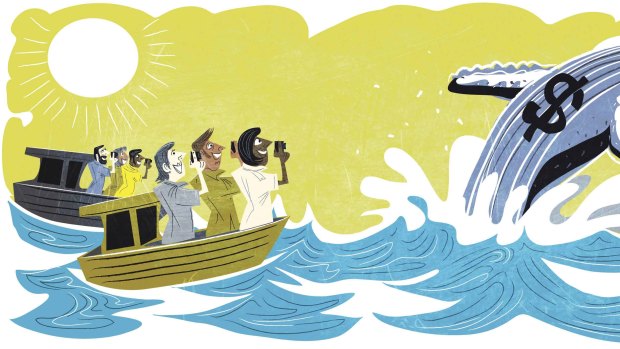By Jane E. Fraser

Illustration: Michael Mucci.
Humpbacks star on the east and west coast, and southern rights off Victoria - watching Australia's whales migrate has grown into a $260 million industry.
JILL PERRY thought her husband Brian had gone mad when he first proposed operating whale-watching tours in the waters off Queensland's Hervey Bay.
Even the local paper tried to talk the fisherman out of running an advertisement, saying it would be a waste of money; that no one wanted to see whales.
The Perry family is this year celebrating its 25th season of commercial whale-watching tours in Hervey Bay, credited with starting an industry now worth more than $260 million a year to Australian tourism.
The phone rang off the hook when that small advertisement appeared in the paper in 1987 and it now rings to the tune of thousands of passengers each year.
In What's a Whale Worth?, a report by the Melbourne firm Economists at Large for the International Fund for Animal Welfare (IFAW), whale watching in Australia is reported to produce more than $47 million a year in ticket sales and more than five times that amount in total tourism expenditure. The report gives an average "value per whale" of $97,000 for Hervey Bay, giving substance to the argument that the creatures are worth much more alive than they are dead.
In the Victorian town of Warrnambool, where large numbers of tourists go to see a relatively small population of southern right whales, the value of each whale is calculated at nearly $1.3 million.
An interesting study into the tourism versus hunting calculations is Tangalooma, on Queensland's Moreton Island.
Having operated as a whaling station from 1952 to 1962, it is now a tourist resort that took 7500 visitors on whale-watching trips last year.
What was not sustainable as a hunting operation has been very successful as a nature-based tourism operation.
Jill and Brian Perry took 32 passengers on their first whale-watching trip, during which toilet rolls were dropped from a light plane to show the boat which way to go.
Their business, Hervey Bay Whale Watch, now takes about 12,000 passengers a year, with the total for all Hervey Bay operators at around 56,000 passengers a year.
Around Australia, the number of people taking part in whale watching is more than 1.6 million a year, according to the IFAW report.
Commercial whale-watching operations are now established in every state, from Cape Leveque in northern Western Australia to Bruny Island in Tasmania.
Humpback whales are the star performers up and down the east and west coasts, while in South Australia and other places along the southern coastline it is southern right whales.
Apart from growing awareness of whales and nature-based tourism, one of the biggest factors in the growth of whale tourism has been the steadily increasing numbers of whales since hunting ended in the late 1970s.
Jill Perry says there were only a few hundred whales visiting Hervey Bay when they started tours in the 1980s, compared with at least 5000 now.
"It's only in the last 10 years that the numbers have been increasing dramatically," she says.
"We never saw a calf in the first two years, now we've seen thousands."
One whale that visits Hervey Bay each year, Nala, has had nine calves in the time the Perry family has been watching her. "She's a super mum," says Perry.
The total east coast humpback population is thought to be about 15,000 and at least a third of these come into Hervey Bay to rest and play each season, which runs from July to early November.
However, total numbers are still a long way short of the up to 40,000 humpbacks estimated to have been in the east coast population in the 1940s.
"I don't know that we'll ever get back to that amount," says Perry, who says Japanese whaling and other man-made issues such as shark nets represent an ongoing threat to whale populations.
Unsurprisingly, toilet rolls are no longer used in the business of whale watching, although little in the way of technology has replaced them.
Perry says apart from logging GPS co-ordinates on where whales have been seen, the greatest tool remains human eyesight.
"There is no technology in finding a whale, it's just eyes, it's just watching for them," she says.
Perry says all the operators in Hervey Bay are in constant radio contact and share information on where whales have been spotted.
With more whales and more boats, the gentle giants are getting easier and easier to find.
Close encounters
If you want to see whales up close, Hervey Bay is still the best place to go. In most places around Australia, whales are seen on the move, as they migrate to breeding or feeding grounds. But in the calm waters between Hervey Bay and Fraser Island, humpback whales stop to rest and play for several weeks, or longer in the case of mothers with calves. Whales are naturally curious and react to the presence of boats and people, regularly breaching and "performing" within metres of the whale-watching vessels.
jane@janeefraser.com.au
Sign up for the Traveller Deals newsletter
Get exclusive travel deals delivered straight to your inbox. Sign up now.